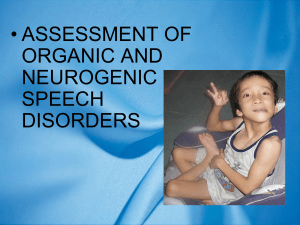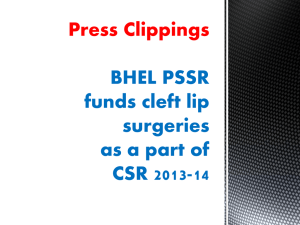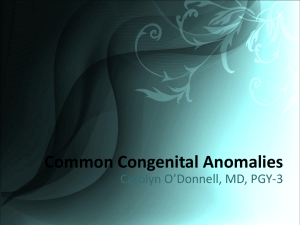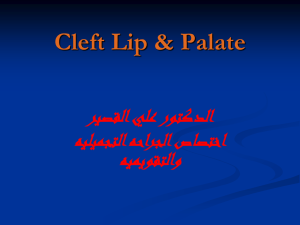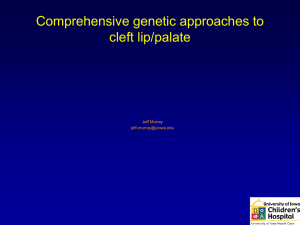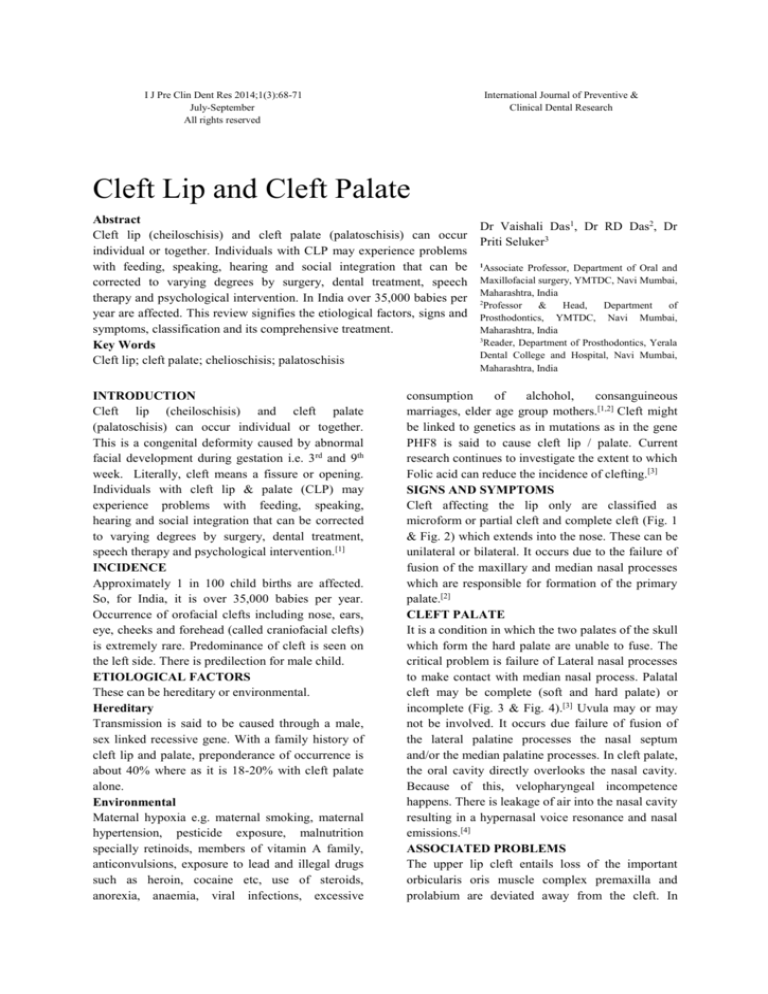
I J Pre Clin Dent Res 2014;1(3):68-71
July-September
All rights reserved
International Journal of Preventive &
Clinical Dental Research
Cleft Lip and Cleft Palate
Abstract
Cleft lip (cheiloschisis) and cleft palate (palatoschisis) can occur
individual or together. Individuals with CLP may experience problems
with feeding, speaking, hearing and social integration that can be
corrected to varying degrees by surgery, dental treatment, speech
therapy and psychological intervention. In India over 35,000 babies per
year are affected. This review signifies the etiological factors, signs and
symptoms, classification and its comprehensive treatment.
Key Words
Cleft lip; cleft palate; chelioschisis; palatoschisis
INTRODUCTION
Cleft lip (cheiloschisis) and cleft palate
(palatoschisis) can occur individual or together.
This is a congenital deformity caused by abnormal
facial development during gestation i.e. 3rd and 9th
week. Literally, cleft means a fissure or opening.
Individuals with cleft lip & palate (CLP) may
experience problems with feeding, speaking,
hearing and social integration that can be corrected
to varying degrees by surgery, dental treatment,
speech therapy and psychological intervention.[1]
INCIDENCE
Approximately 1 in 100 child births are affected.
So, for India, it is over 35,000 babies per year.
Occurrence of orofacial clefts including nose, ears,
eye, cheeks and forehead (called craniofacial clefts)
is extremely rare. Predominance of cleft is seen on
the left side. There is predilection for male child.
ETIOLOGICAL FACTORS
These can be hereditary or environmental.
Hereditary
Transmission is said to be caused through a male,
sex linked recessive gene. With a family history of
cleft lip and palate, preponderance of occurrence is
about 40% where as it is 18-20% with cleft palate
alone.
Environmental
Maternal hypoxia e.g. maternal smoking, maternal
hypertension, pesticide exposure, malnutrition
specially retinoids, members of vitamin A family,
anticonvulsions, exposure to lead and illegal drugs
such as heroin, cocaine etc, use of steroids,
anorexia, anaemia, viral infections, excessive
Dr Vaishali Das1, Dr RD Das2, Dr
Priti Seluker3
1
Associate Professor, Department of Oral and
Maxillofacial surgery, YMTDC, Navi Mumbai,
Maharashtra, India
2
Professor
&
Head,
Department
of
Prosthodontics, YMTDC, Navi Mumbai,
Maharashtra, India
3
Reader, Department of Prosthodontics, Yerala
Dental College and Hospital, Navi Mumbai,
Maharashtra, India
consumption
of
alchohol,
consanguineous
marriages, elder age group mothers.[1,2] Cleft might
be linked to genetics as in mutations as in the gene
PHF8 is said to cause cleft lip / palate. Current
research continues to investigate the extent to which
Folic acid can reduce the incidence of clefting.[3]
SIGNS AND SYMPTOMS
Cleft affecting the lip only are classified as
microform or partial cleft and complete cleft (Fig. 1
& Fig. 2) which extends into the nose. These can be
unilateral or bilateral. It occurs due to the failure of
fusion of the maxillary and median nasal processes
which are responsible for formation of the primary
palate.[2]
CLEFT PALATE
It is a condition in which the two palates of the skull
which form the hard palate are unable to fuse. The
critical problem is failure of Lateral nasal processes
to make contact with median nasal process. Palatal
cleft may be complete (soft and hard palate) or
incomplete (Fig. 3 & Fig. 4).[3] Uvula may or may
not be involved. It occurs due failure of fusion of
the lateral palatine processes the nasal septum
and/or the median palatine processes. In cleft palate,
the oral cavity directly overlooks the nasal cavity.
Because of this, velopharyngeal incompetence
happens. There is leakage of air into the nasal cavity
resulting in a hypernasal voice resonance and nasal
emissions.[4]
ASSOCIATED PROBLEMS
The upper lip cleft entails loss of the important
orbicularis oris muscle complex premaxilla and
prolabium are deviated away from the cleft. In
69
Cleft lip and cleft palate
Das V, Das RD, Seluker P
Fig. 1
Fig. 2
Fig. 3
Fig. 4
Fig. 5
Fig. 6
Fig. 7
Fig. 8
Fig. 9
bilateral cases, premaxilla and prolabium project
anteriorly and columella is extremely short. Feeding
Fig. 10
is a major problem since structural defects of cleft
lips and palate prevent negative oral pressure
70
Cleft lip and cleft palate
required for sucking.[5] Other effects include speech
articulation errors, like distortions, substitutions and
omissions, compensatory misarticulations and
mispronunciations (e.g. glottal soaps) and posterior
nasal fricatives.[5] Since equalisations of pressure by
swallowing is hampered, there is greater
susceptibility to middle ear infections. There could
be hearing loss.[1,5] Change in dynamics of growth
potential affects the growth of maxilla resulting in
functional and aesthetic impairment and functions.
PSYCHOSOCIAL ISSUES
A cleft lip and /or palate may impact an individuals
self esteem, social skills and behaviour. A larger
amount of research is dedicated to the psychological
development of individuals with this deformity.
Strong parent support networks may help to prevent
the development of negative self-concept in these
children. They often deal with threats to their
quality of life for multiple reasons including
unsuccessful social and interpersonal relationships,
deviance in social appearance and multiple
surgeries.[4]
CLASSIFICATION
Davis and Ritchie in 1922[6] and Veau in 1931 gave
simple classifications. But, the internationally
accepted classification advocated by FoghAnderson in 1942 and confirmed by Kernahan and
Stark (1958)[7] is as follows:
A) Group I-Cleft of the anterior (primary) palate
1. Lip: Unilateral Rt/Lt - Total or partial: Bilateral
2. Alveolus: Unilateral Rt/Lt - Total or partial:
Bilateral
B) Group II - Cleft of anterior and posterior palate
1. Lip: Unilateral Rt/Lt – Total or partial: Bilateral
2. Alveolus: Unilateral Rt/Lt - Total or partial:
Bilateral
3. Hard palate: Unilateral Rt/Lt - Total or partial:
Bilateral
C) Group III - Clefts of posterior palate
1. Hard palate: Rt/Lt
2. Soft palate
(Fig. 5-10)
D) Group IV - Rare facial clefts
MANAGEMENT OF CLEFT DEFECTS[8]
Aims and Objectives
1. To correct the defect surgically and make it
aesthetically acceptable.
2. To improve speech articulations.
3. To correct malocclusion.
4. To increase the self-esteem of the affected child.
Das V, Das RD, Seluker P
MULTIDISCIPLINARY APPROACH[9]
Management of cleft lip remains an enigma and a
challenge. Spatial relationship and function of
muscular elements causing this deformity has to be
understood for a functional correction of cleft lip
and palate. A team of trained doctors including
plastic surgeons, Oral and Maxillofacial surgeons,
ENT
surgeons,
speech
therapists,
child
psychiatrists,
well-trained
nursing
staff,
Orthodontist, Prosthodontists, Paediatrician are too
involved for rehabilitation of a cleft case.
GENERAL GUIDELINES[1,9,12]
1. Immediately after birth: Paediatric consultation,
geneticist evaluation to diagnose if any
associated syndrome is present. Parent
counselling and feeding instructions to be given.
2. After a few weeks: Hearing evaluation and
weight evaluations.
3. Depending upon the weight of the baby,
according to the rule of 10, i.e. weight minimum
of 10lbs, haemoglobin 10mg and 10 weeks, lip
repair can be undertaken.
4. Between 1 year and 18 months: Surgical repair
of palate after surgical evaluation.
5. Post-palatal repair: Speech and language
assessment and speech therapy to be ensued.
6. Psychological evaluation, treatment of middle
ear infections.
7. Alveolar bone grafting depending upon the
defecting size.
8. Orthodontic treatment after age of 11years.
9. Upto 18 years: End of orthodontic corrections
and miscellaneous dental treatments.
10. Evaluation of maxillary growth. If required
surgical advancement of maxilla post puberty.
11. Rhinoplasty if required.
12. Psychological support throughout these phases
and later.
PRESURGICAL DEVICES
Nasoalveolar moulding prior to surgery can
improve long term nasal symmetry with complete
unilateral cleft lip - cleft palate patients compared to
correction surgically alone; according to a
retrospective cohort study.[10,11]
SURGICAL REPAIR
A ideally repaired cleft lip should provide a
symmetrical cupid’s bow and philtrum with a
minimal scar.[12] The most popular method for
unilateral repair is rotation advancement technique
introduced by Millard in 1958.[8] Millard repair
aimed at lengthening of the skin of the lip
reconstructing orbicularis oris muscle and
71
Cleft lip and cleft palate
Das V, Das RD, Seluker P
Table 1: Depending upon the severity of the Cleft, Distraction Osteogenesis, Orthognathic Surgery and Secondary
Corrections can be done
age
Treatment
Rationale
At birth
Feeding plate
Sucking milk
2-3 months
Lip repair
Feeding and aesthetics
Sealing the oronasal communication,
9-11 months
Palate repair
Enhance speech and feeding
3 years
Pharyngoplasty if needed
Correction of nasal twang
3 years
Premaxillary setback in case of bilateral cases
Creation of labial vestibule,better speech and aesthetics.
3 years
Cleft alveolar bone closure using BMP
Closing alveolar cleft
Cleft alveolar bone closure with bone
7years
Closing alveolar cleft
grafting
13 years
Cleft orthodontics
Aligning the teeth correctly
14-16 years
Rhinoplasty if needed
Aesthetics
reconstructing the full height of the labial sulcus.
Simultaneous reconstruction of the nasal deformity
should be considered in the form of columellar
lenghthing and repositioning of the misplaced alar
cartilage.[8] To date, several surgeons have modified
this basic technique according to their convenience
and variations of the cleft. Describing all the
techniques is not possible under purview of this
article.
Repair of Palate[11]
Primarily it aims at the repositioning of the palatine
muscles and surgical repair of palate functionally.
Veau (1931) modified the Langenback’s operation
of pushback. Wardill (1933-37) evolved four flap
method of repair. Skoog used a mucoperiosteal flap
to cover the raw surface which helps growth of
tooth in this segment. Adenwalla and Narayanan
(2009) modified the repair of uvula for better
velopharyngeal competence. Alveolar bone graft is
ideally performed prior to eruption of lateral
incisors or canines, to be able to prevent loss of a
tooth due to eruption into an ungrafted cleft
alveolus. This age is considered to be around 5 to 6
years of age. Bone grafting allows these teeth to
erupt in solid bone and provides enhanced
stabilization of the maxilla.[13] Transverse maxillary
growth is also nearly complete by this age, so that
there is no inhibition of maxillary growth in this
dimension. Though several different techniques
described delayed alveolar bone, an elegant
straightforward approach was described by Craven
et al. The defect is viewed three dimensionally.
Both cortical and cancellous bone is utilized. SM
Balaji has demonstrated use of rh Bone
morphogenetic protein-2 as an ideal bone
reconstructive material for alveolar clefts.[14]
Comprehensive treatment protocol as laid down by
SM Balaji is on Table 1.
REFERENCES
1. Dixon MJ, Marazita ML, Jeffery C. Cleft lip
and palate; synthesizing genetic and
environmental influences. Nat Rev Genet Mar
2011;12(3);168-78.
2. Mallik N: Textbookof Maxillofacial surgery,
507-524.
3. Cleft palate genetic clue found BBC news.
2004-08-30.
4. Tobiasen JM. Psychosocial co-relates of
congenital cleft palate. J 1998;21(3):131-9.
5. Gillies H, Millard DR Jr. The Principles and
Art of Plastic Surgery. Vol 1 Boston: Little
Brown and company: 1957.
6. Davis JS, Ritichie HP. Classification of
congenital clefts of the lip and the palate.
JAMA 1992;79(16):1323-32.
7. Kernahan DA, Stark RB. A new classification
for cleft lip and palate. Plastic reconstr Surg.
1958;22(5):441.
8. Millard DR Jr. A radical rotation in single
harelip. Am J Surg 1958;95(2):318-22.
9. Adenwalla, Narayanan. Surgical correction of
facial deformities by Vargese Mani.153-83.
10. Grayson BH, Shetye P. Presurgical
nasoalveolar moulding treatment in cleft lip
and palate patients. Indian J Plast Surg.
2009;42(suppl);56-61.
11. Chammanam SG, Biswas PP, Kalliath R,
Chiramel S. J Maxillofac Oral Surg
2014;13(2):87-91.
12. Mehrotra D, Pradhan R. Cleft lip: Our
experience of repair. J Maxillofacial Oral
surgery 2004;9(1):60-3.
13. Semin Plast Surg. 2012:26(4):178-83
14. SM Balaji, Journal of maxillofacial and oral
surgery 8(3),211-217,2009.


